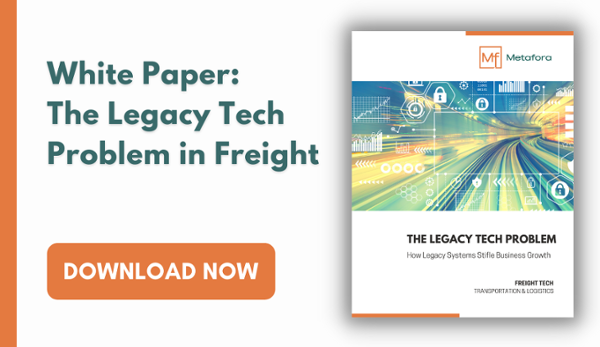How Freight Brokers Win More Business and Increase Profitability with Hyperdynamic Pricing
Pricing in trucking, particularly in truckload transportation, has largely been dynamic since deregulation. The access to capacity ebbs, shipper demand flows, and prices move accordingly. With the increase in access to data, the demand on transportation providers to be more responsive to market movements has fundamentally changed the spot market pricing.
Today and going forward, hyperdynamic pricing might be the single most important tool freight brokers have in increasing profitability and winning more business. It's a valuable part of a larger tech strategy in freight. As most transportation companies have experienced, speed is essential in spot pricing. From the shipper's perspective, the process of sorting through bids can be tedious and drawn-out, and it's because of their frustration with this process that shippers prefer to go with the provider that responds with the best spot market rate in a short amount of time.
A timely response is critical. By being one of the first to respond, freight brokers increase the chances they'll win the load. However, with faster responses comes the increased chance of mistakes and human error—unless the broker is equipped with the technology for hyperdynamic pricing.
The strategy of dynamic pricing
The success of freight brokers and carriers submitting bids has always revolved around their ability to price strategically. Through all this, the market is constantly changing, making brokerage a speed-of-information game. The quicker they can react to the moving market, the better off the business is.
Information and data are key. When a broker has the information to make better rate decisions, they have a competitive edge; they choose their rates low enough to appeal to the shipper and at the same time, rates high enough to earn the profit margin they need. The same is true in procurement. Take decisions on a truck are among the most difficult decisions a broker makes and have the largest impact on profitability, particularly as it relates to cost of service.
In the past, larger organizations had the obvious advantage. They had the data needed for strategic pricing because they had more volume of shipments and therefore a wider view of the market. Small and mid-market brokers lacked the freight volume and variety to get a clear and reliable picture from the market, particularly in real time. Moreover, many lacked the tools to leverage their own data in pricing. While tools like DAT RateView or Truckstop Ratemate could aggregate rates and give brokers some indication of the market, available tools lagged the market substantially and did little to help users make a decision about the right course of action right now.
Another issue is the concept of a “market rate.” Ryan Schreiber, Director of Engagement for CarrierDirect explains, “The issue is that there is no one rate on a lane. Every broker has experienced exactly this. There are so many factors that will impact the strike price on a shipment with a carrier: what the appointments are like, what the commodity is, who the shipper or receiver might be. Knowing “market rate” on Atlanta to Dallas is helpful, but if you’ve got floor loaded mattresses that are going to require driver assist, it’s directional at best.”
With today's tools, we have access to real-time market data, available to any size organization, plus, more importantly, the ability to analyze this large quantity of data quickly and turn it into rate recommendations that brokers can act on to increase profitability and decrease cost of service. And there is now a third piece: access to machine learning. This can take in an individual company's real-time bidding outcomes and continuously improve the system for future bids.
Dawn Salvucci-Favier, CEO of Greenscreens.ai describes company-specific machine learning:
"Not every company is going to pay the market average. Some have different areas of specialty or regions that they perform really well in. In some areas, they may buy better than the market average... By taking the customer's data and training the machine learning model on the buying behavior of an individual company, it allows us to produce a very accurate, predicted price for the individual company."
Ryan adds “It is essential to continually improve how you price customers and procure transportation. However, winning a shipment that you will lose money on does not do anyone any good, and it does not help your other strategic goals, like driving automation, client service, or building your capacity network.”
Freight brokers and carriers can employ tools to stay on the leading-edge of pricing strategy.

Benefits of dynamic pricing and decision assistance
The goal of hyperdynamic pricing is to improve the reliability of the rates produced so that the first rate is the best rate (the one that wins the bid) but also one that is profitable.
Decisioning tools, including hyperdynamic pricing tools, synthesize large amounts of data and calculate a recommendation along with a confidence score. These tools are typically deployed where humans are inefficient and unreliable. Data analysis in the hands of a person is time-consuming and prone to errors. Hyperdynamic pricing technology helps brokers make better informed decisions faster. This drives efficiency and leads to fewer errors. The process does not depend on the human element, though there is room in the final decision for the broker to make an adjustment as he or she sees fit.
As just one example, every broker is trying to grow gross profit, and every broker also quotes or takes loads which will lose money. While there are a number of reasons for loads being losers, one of the prime drivers is errors in the quoting process. Dawn shares that GreenScreens.ai users can reduce losing loads by up to 25%. This has a meaningful margin impact as avoiding them is money straight to the bottom line. While on a load average basis the money might not seem meaningful, look at your last 30 days of load history, add up all the lost gross profit, and add 25% of that money back into your numbers. This is to say nothing about the extreme “soft costs” in servicing losing loads.
Depending on how they are deployed, tools like hyperdynamic pricing can have varying degrees of human interaction. As an example, if the particular circumstance returns a low confidence score, some engines provide a user with additional information that the broker needs to factor in, such as data density and market conditions, and the ability to adjust. When the confidence score of the data is high enough, decisioning tools like hyperdynamic pricing, present opportunities for automation: the ability to return a rate in real time to a customer or a carrier through API, email, or other channel. An added benefit is these tools help improve the quality of their digital freight bookings.
Dawn shared some additional data that these impacts can help increase win rates on spot quotes up to 20%, and increase spot volume by 10% without adding headcount. These numbers are consistent with what Metafora sees across the industry.
A hyperdynamic pricing engine can provide the recommended rate for buying plus the recommended rate for selling to a carrier. The algorithm may factor in an individual company's historical profit margins, which when taken into account with the rate's confidence score, can assist the freight broker with carrier negotiations. Some companies also build controls or overrides for users or administrators, but the goal remains the same: lower the cost of service by presenting the users with recommendations, and increasing profitability by having fewer errors from institutional knowledge. “All these benefits can result in up to a 3% annual gross margin improvement” Dawn shared.
 Getting started with hyperdynamic pricing
Getting started with hyperdynamic pricing
Input data for hyperdynamic pricing models come from two main sources:
- Aggregate market data—accessible by any organization such as is available in Freightwaves Sonar product, or DAT’s RateView product
- The individual company's historical data
The model uses load transactions ideally from the past year or longer to provide a base of information. New companies can still start with less than a year of data; they simply rely more heavily on machine learning. The system quickly adapts to the incoming information, increasing its confidence scores and decreasing its margin of error over time.
Typically, companies only need to provide basic data from their buying transactions to get started—for example: origin, destination, equipment type, pickup date, price, etc.—plus information on the side of selling to the carrier for the machine learning algorithm to learn the behavior of the broker's carrier relationships. Over time, the algorithm becomes more effective at both the buying and selling rate recommendations.
Metafora (formerly CarrierDirect) provides analysis and insight for freight brokers considering a hyper dynamic pricing solution. We consider your unique company circumstances to lead you to a solution that helps you win more business more efficiently.
Greenscreens.ai provides data aggregation, market intelligence, and dynamic pricing. Greenscreens.ai’s mission is to be the industry-leading neutral platform for market data aggregation, market intelligence and dynamic pricing. Providing customers with high-confidence, predictive buy rate guidance and differentiated pricing strategies that are powered by the industry's most up-to-date and contextually relevant dataset. Fueled by transaction data from shippers, carriers, brokers, leading market data sources within the Greenscreens.ai network and executed within the context of their existing technology ecosystem and workflow.






